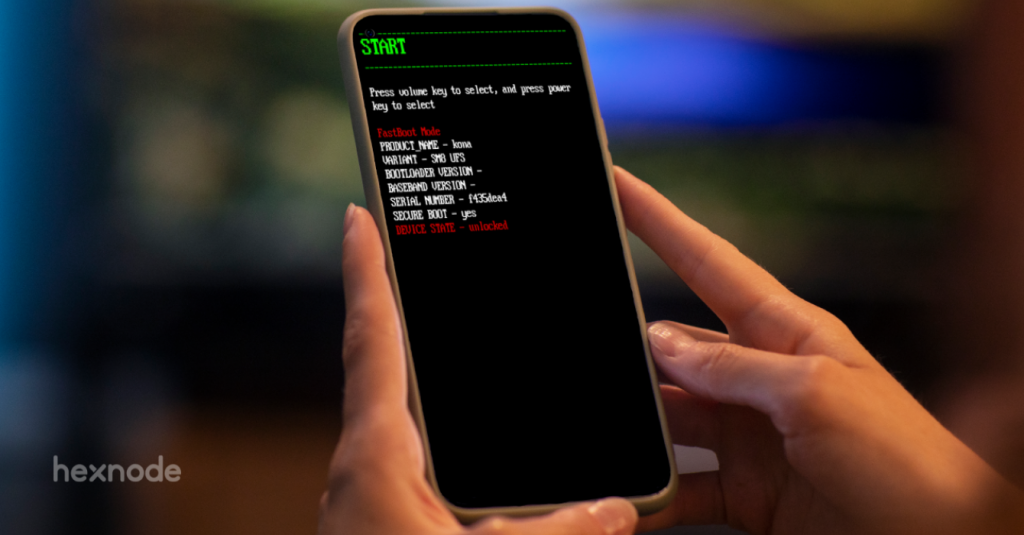The big ‘HOWs’ of managing custom Android OS (custom ROM) in the workplace
Unlock the secrets of managing custom Android OS at work. Streamline operations with our insightful guide.

Get fresh insights, pro tips, and thought starters–only the best of posts for you.

Android Fastboot is a protocol used in Android devices to re-flash the device’s partition on a fundamental level. It allows users to send commands to the bootloader. This in turn, facilitates the installation of new firmware and customization options. Fastboot operates in the bootloader environment, enabling you to send commands from your computer to the bootloader and, consequently, initiate processes like flashing custom ROMs or making fundamental changes to the device’s software.
Android Fastboot gives the admins greater control and customization over the managed Android devices. Unlike the standard user interface, Fastboot allows users to interact with the device’s bootloader directly. This capability opens an array of possibilities for customization, troubleshooting, and upgrading.
Access to the latest software and OS updates: Fastboot enables users to install the latest Android firmware manually. This is particularly useful for individuals who want to stay ahead of official OTA updates or for devices that may no longer receive official support.
Access to additional features and functionalities: Fastboot facilitates the installation of custom ROMs. Custom ROMs can be optimized for better performance, offering a smoother and more responsive user experience. This process unlocks additional features and functionalities that might not be present in the stock Android version provided by the phone manufacturer.
Improve battery life: Improving battery life is one of the advantages of Android Fastboot, as certain custom ROMs optimized for power consumption can lead to enhanced battery performance compared to the stock Android version.
Better privacy and security: Leveraging the advanced privacy and security features (in custom ROMs) through Android Fastboot grants users enhanced control over privacy settings, ensuring heightened data security.
Remove bloatware: Bloatware, or pre-installed apps that come with the device, can be a source of frustration for users. Fastboot allows the removal of such unwanted applications, freeing up valuable storage space and enhancing device performance.
Provide a personalized experience: Fastboot empowers users with extensive device personalization capabilities, encompassing customization of the interface’s aesthetics and functionality. These options extend beyond the usual allowances found in standard Android settings.

It might be challenging for IT admins to manage a huge number of Android devices. Hexnode UEM makes Android device management a seamless experience for them. Check out the White paper to know how.
Download the White paperFastboot mode opens a host of commands and actions. To understand this better, let’s look at a situation.
Consider an organization managing a fleet of Android devices deployed across different departments. Now, the IT admins of the organization face many challenges as they manage the different Android phones deployed in the organization. They must standardize security measures, customize configurations for different departments, optimize device performance, and also ensure efficient troubleshooting procedures. So, the admins seek a solution to these issues to ensure a streamlined and secure device management process while maximizing the productivity and functionality of its Android device ecosystem.
In this case, Android Fastboot becomes very handy for the IT department. We have listed down five ways how you can make the best use of Android Fastboot.
Fastboot mode unlocks the bootloader, a key functionality for the IT department seeking to standardize and secure the organization’s device ecosystem. By unlocking the bootloader using Fastboot commands, the IT team can control the devices’ firmware, ensuring a standardized and secure booting process across the entire fleet.
Imagine a scenario where specific departments within the organization require custom recovery images tailored to their unique workflow needs. Here, Fastboot mode becomes the gateway for efficiently flashing these custom recovery images onto the mobile phones. This provides a consistent recovery environment and ensures a streamlined recovery process in case of any unforeseen issues.
To meet specific departmental requirements or to address performance issues, the IT department can make use of Android Fastboot to install custom ROMs and firmware. This allows deployment of customized software configurations, ensuring that each set of devices is optimized for its intended use, thereby enhancing overall efficiency and productivity.
Whenever a device encounters persistent issues or needs a clean slate, Fastboot’s ability to wipe and format partitions can come in handy. This allows the IT team to troubleshoot and resolve problems efficiently, restoring devices to a stable state and minimizing downtime for end users.
Lastly, Fastboot mode’s debugging and troubleshooting capabilities empower the IT department to address issues promptly. By harnessing Fastboot mode, technicians can run diagnostic commands, identify and rectify software glitches, and ensure the smooth operation of Android devices within the organization.
A custom Android OS, often referred to as a custom ROM, is a modified version of the Android operating system. Custom ROMs can be tailored to offer unique features, optimizations, and visual enhancements beyond what the device manufacturer provides.
While the benefits of custom ROMs are enticing, it’s crucial to consider the potential risks involved. Flashing a custom ROM carries certain risks, including:
Flashing custom ROMs on work devices requires a careful approach. However, there are situations where it can be beneficial:
Managing devices with custom Android OS in the workplace requires a robust Unified Endpoint Management (UEM) solution. Hexnode UEM offers a comprehensive solution for enrolling, managing, and securing devices with custom ROMs.
The process begins by acquiring corporate Android phones directly from your registered OEM vendor and instructing them to install a custom ROM using Hexnode UEM as a pre-built system app. This ensures that the UEM app receives the necessary permissions. Once the phones reach end-users, they are automatically enrolled in the Hexnode portal upon the first power-up.

After the initial activation, a ROM-configured Android boots into lost mode, providing options to connect to the internet. Upon connecting to a network, the enrollment process commences, and upon successful enrollment in your Hexnode portal, the device exits lost mode. All configured policies and settings from the Hexnode portal are then seamlessly applied over the air to the enrolled mobile phones.
Android Fastboot opens the door to endless possibilities for customization and optimization of an Android phone. From installing the latest software updates to unlocking additional features through custom ROMs, Fastboot empowers users to take control of their Android experience. However, considering the potential risks involved, it’s crucial to approach customization with caution. With the right knowledge and tools, users can harness the full potential of Android Fastboot, creating a personalized and enhanced mobile experience.
Try out Hexnode UEM for free to effectively manage your Android devices.
Sign up now